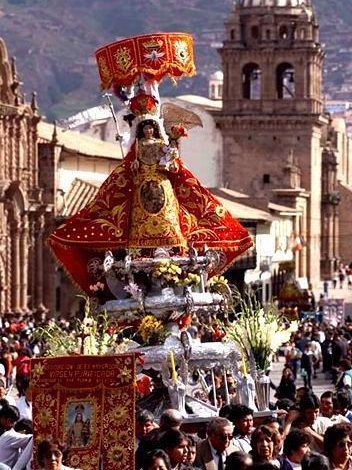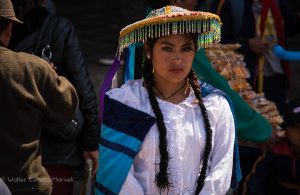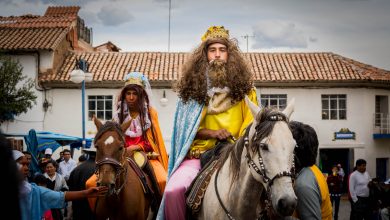The Virgin vs the Official Schedule of Festivities: Two Cultures in Cuzco

The Virgin of Natividad, Almudena made her way along the side of the Plaza on Sunday morning back to her chapel at the same time the national flag was to be raised in a formal celebration. While watching the energy and drama of her procession several things struck me about what seem two different currents of culture and folklore in the city.
The Virgin’s people had gathered Sunday morning, early, in the Plazoleta of Santa Catalina. Several of the dance troupes had danced their way there, such as the Qhapaq Qollas and the Tinkus. Others, such as the Morenadas and the Qhapaq Negros gathered there.
She entered the chapel of Santo Domingo and was placed on her palanquin by the altar. Her ukukus danced for her inside the chapel.
I did not stay to see all that was happening, because of pressure to write a note. By the time I was done writing I could hear the first band calls that began her procession back along the Compañía side of the Plaza towards Espaderos and Regocijo before going to Almudena..
The procession began a bit before 10 am. On the Cathedral side of the Plaza, the loudspeaker was already calling people to the Iza de la Bandera, the raising of the flag, which was scheduled and for which dance troupes had already marched in. In addition, dancers in costume were gathering for the scheduled 11 am parade of dancers from ESSALUD Centers for Older Adults followed at 11:30 by dances from the various markets of Cuzco.

The Virgin’s procession overwhelmed the loudspeaker and I do not even know if they actually carried out the Iza de la Bandera. What I find interesting is that the procession does not appear on the formal Schedule of Celebrations for 2015 for today established by the EMUFEC, the Municipal agency responsible for scheduling and carrying out festivities.
Corpus Christi does, but the processions of the Saints and their dance groups through the Plaza on their way from the Cathedral to their home temples do not.

In this I read an institutional separation and challenge. It may be that the Archbishop and the archdiocese are tied into EMUFEC for the scheduling of feasts such as the main Corpus Christi Mass and procession as well as the procession of the Lord of Temblors during Holy Week. It also may be that the parishes schedule the Saints’ return home independently, along with the fraternities, hermandades, organized around the saints. These may be separated from EMUFEC by this institutional separation between archdiocese and parishes with heir fraternities.
Nevertheless, the official schedule of events is filed with small happenings, book presentations, performances, and food fairs that pale in comparison to the major saint’s processions. These happenings, outside of the processions and major parades, are culture and important culture to some people but they are a differently organized and located culture than that of the Saint’s processions which in their own way claim precedence by simply cutting through traffic and through other events on the Plaza and elsewhere in the city.
Around these two worlds of culture is a growing separation of Church and society, though the vast majority of the people of Cuzco claim to be Catholics on the census. They also represent a division between the parishes and the formal institutions of culture established within the city.
There are two cultures of dance troupes, as a result, that are found within the city, although interrelated and composed of parades and processions. The official civic one draws on the institutions of civic society—schools, universities, businesses, and public institutions—to perform dances from the set of codified dances defined as typical of Cuzco, while the other draws on the hermandades—the brotherhoods or confraternities—who organize themselves around dance as devotion to a holy figure.
These last also involve sponsorship, i.e jurkas and majordomos, responsible for organizing and carrying out the feast, while the former do not require this necessarily although devotion to a holy figure may be part of institutional reality. Instead they are primarily civic rather than religious organizations, while the latter are religious and societal.
The procession is an ongoing reality—a performance that covers lots of space with occasional stops for the saint and its bearers to rest. It involves religious figures and incense enmeshed in fraternities with dancers before and after. In contrast, the civic dances are performed as if on stage, they involve a square or rectangular space set up for performance, along the three sides of the plaza, in school yards, or in coliseums when there are competitions or festivals of typical dance, official folklore.
The religious dancers not only accompany the saint in continuous procession with occasional stops where they dance along the way and not in square staged spaces.
They also follow the sponsors and their sacred objects, their demandas or small holy figures. In contrast the civic dancers follow banners that announce the organization and sometimes the official role of the dancers within that institution.
Even though the religious processions move through public space and involve a creation of a civic order which gives precedence to the Church and to holy figures, they do not involve at any given time as large a percentage of the people as do the civic parades and festivals. In the main procession for Corpus Christi around the plaza, I estimated somewhere around 3000 people participated, while the institutional parades will involve most everyone in Cuzco directly or indirectly, especially with the parades of school children.




